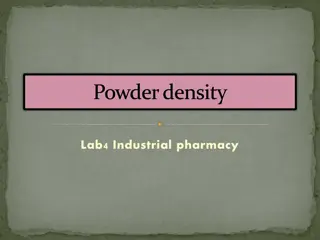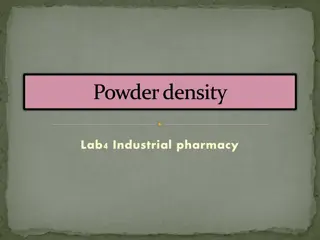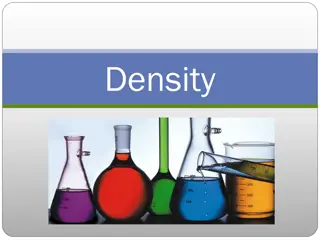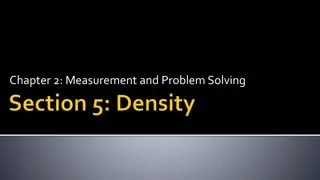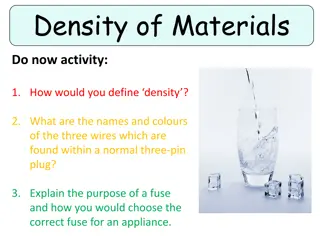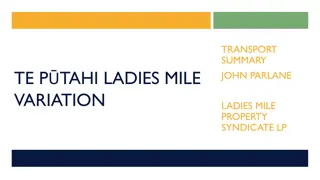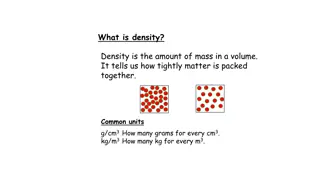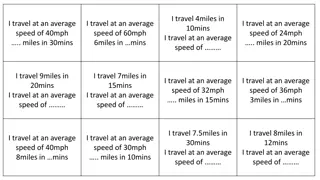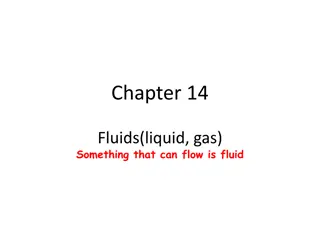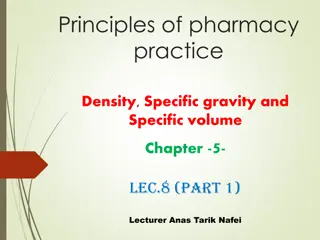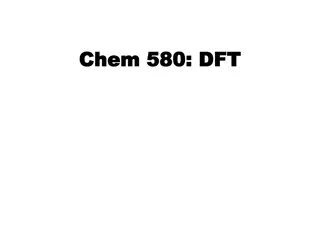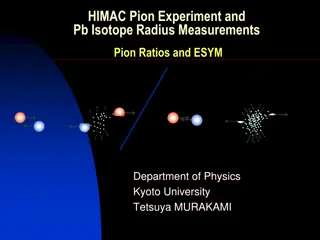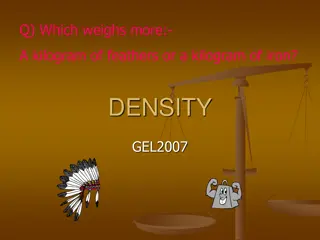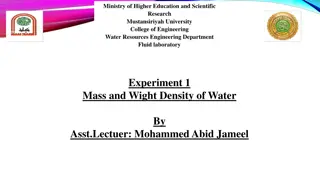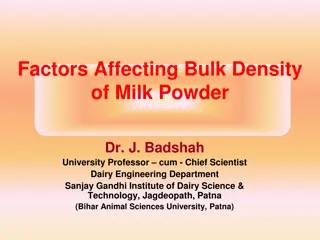Understanding Density and Related Concepts in Physics
Explore the concept of density and related terms such as mass, viscosity, buoyancy, volume, and more in physics. Learn how to calculate density, understand mass and volume relationships, and solve problems involving the properties of different materials. Discover the principles behind buoyancy, viscosity, and the measurement of matter in various contexts.
Download Presentation

Please find below an Image/Link to download the presentation.
The content on the website is provided AS IS for your information and personal use only. It may not be sold, licensed, or shared on other websites without obtaining consent from the author. Download presentation by click this link. If you encounter any issues during the download, it is possible that the publisher has removed the file from their server.
E N D
Presentation Transcript
Density Get the tools: Lab book CPS Remote Calculator
density: the amount of matter (mass) in a given unit volume.
mass: the measure of the amount of matter an object contains.
viscosity: the resistance of a liquid to flow (viscous).
buoyancy: the tendency or capacity to remain afloat in a liquid or rise in air or gas; the upward force that a fluid exerts on an object less dense than itself.
volume: The amount of space occupied by something expressed in L, mL or cm3 (or any cubic unit).
Kermit vs. Elephant Explain which has more mass? Volume? Weight?
Cover the variable you are trying to solve for and the formula will appear. m D v
Both are fresh eggs (not boiled). Tap Water Tap Water with salt.
A block of maple wood with a volume of 405 cubic centimeters and a density of 0.67 g/cm3 is sawed in half. The density of the two smaller blocks is now_____. (Spr'03 11th -25)
A block of maple wood with a volume of 405 cubic centimeters and a density of 0.67 g/cm3 is sawed in half. The density of the two smaller blocks is now_____. (Spr'03 11th -25) A. one-fourth the original density B. one-half the original density C. two times the original density D. the same as the original density
12 grams 6 grams 6 cm 6cm 3cm 12 cm 6cm 3cm 6cm*12cm*3cm = 216 cm3 6cm*6cm*3cm = 108 cm3 12 g /216 cm3 = .05555 g/cm3 6 g /108 cm3 = .05555 g/cm3
What is the mass of a 500.00 mL sample of seawater with a density of 1.025 g/mL? (Apr'04 10th -18)
What is the mass of a 500.00 mL sample of seawater with a density of 1.025 g/mL? (Apr'04 10th -18) A. 487.8 g B. 500.0 g C. 512.5 g D. 625.0 g
This pipette is filled with a 20% NaOH solution. The solution is at 20oC and has a density of 1.23 g/mL. According to this information, what is the mass of this NaOH solution? (Apr'04 11th -27)
This pipette is filled with a 20% NaOH solution. The solution is at 20oC and has a density of 1.23 g/mL. According to this information, what is the mass of this NaOH solution? (Apr'04 11th -27) A. 3.88 g B. 15.7 g C. 23.9 g D. 24.6 g
Students in a chemistry lab measure the time it takes four different 100 mL solutions to pass through a hole in the bottom of a cup. Which of the following properties of the solutions is most likely being measured? (Apr'06 10th -22)
Students in a chemistry lab measure the time it takes four different 100 mL solutions to pass through a hole in the bottom of a cup. Which of the following properties of the solutions is most likely being measured? (Apr'06 10th -22) A. Buoyancy B. Mass C. Viscosity D. Volume
A sample of water from a stream has a greater density than a sample of distilled water. Which is the best explanation for the difference in density? (Apr'06 10th -29)
A sample of water from a stream has a greater density than a sample of distilled water. Which is the best explanation for the difference in density? (Apr'06 10th -29) A. Streams have kinetic energy. B. Distilled water has a neutral pH. C. Streams can contain dissolved salts. D. Distilled water can contain dissolved gases.
The picture shows the results of pouring a blue liquid into a clear liquid and allowing the mixture to settle for 25 minutes. Compared to the clear liquid, the blue liquid is more _____. (Apr'06 11th -1)
The picture shows the results of pouring a blue liquid into a clear liquid and allowing the mixture to settle for 25 minutes. Compared to the clear liquid, the blue liquid is more _____. (Apr'06 11th -1) A. massive B. dense C. viscous D. soluble
Liquid Description Density (g/mL) Boiling Point (oC) Q Nonflammable colorless compound 1.62 59.5 R Flammable colorless compound 0.71 34.6 S Yellow mixture with strong odor 0.73 160.4 T Viscous pale-yellow oil 0.93 300.0 The table shows properties of four liquids that are insoluble in water. If the four liquids are poured into an Erlenmeyer flask containing water, which liquid will form a layer below the water? (Apr'06 11th -23)
Liquid Description Density (g/mL) Boiling Point (oC) Q Nonflammable colorless compound 1.62 59.5 R Flammable colorless compound 0.71 34.6 S Yellow mixture with strong odor 0.73 160.4 T Viscous pale-yellow oil 0.93 300.0 The table shows properties of four liquids that are insoluble in water. If the four liquids are poured into an Erlenmeyer flask containing water, which liquid will form a layer below the water? (Apr'06 11th -23) A. Q B. R C. S D. T
Swimmers find that they can float more easily in the ocean than in a freshwater pond. The most likely reason for this phenomenon is that the _____.(Jul'04 11th -17)
Swimmers find that they can float more easily in the ocean than in a freshwater pond. The most likely reason for this phenomenon is that the _____.(Jul'04 11th -17) A. viscosity of pond water is greater than that of ocean water B. density of ocean water is higher than that of pond water C. temperature of pond water is lower than that of ocean water D. mass of ocean water is greater than that of pond water
Compared to 250 g of gaseous nitrogen, 250 g of liquid nitrogen has greater _____. (Jul'04 11th -35)
Compared to 250 g of gaseous nitrogen, 250 g of liquid nitrogen has greater _____. (Jul'04 11th -35) A. volume B. temperature C. mass D. density
According to this information, Block Z is most likely composed of _____. (2008 Released 11th - Obj4-1)
According to this information, Block Z is most likely composed of _____. (2008 Released 11th - Obj4-1) A. balsa B. ebony C. maple D. poplar
A 500 mL quantity of vanilla ice cream has a mass of 400 grams. The manufacturer then bubbles air into the ice cream so that its volume increases by 300 mL. What is the ice cream s approximate final density? (Oct'05 11th -18)
A 500 mL quantity of vanilla ice cream has a mass of 400 grams. The manufacturer then bubbles air into the ice cream so that its volume increases by 300 mL. What is the ice cream s approximate final density? (Oct'05 11th -18) A. 0.30 g/cm3 B. 0.50 g/cm3 C. 0.80 g/cm3 D. 1.30 g/cm3
What is the density at 20oC of 12.0 milliliters of a liquid that has a mass of 4.05 grams? (Spr'03 10th -31)
What is the density at 20oC of 12.0 milliliters of a liquid that has a mass of 4.05 grams? (Spr'03 10th -31) A. 0.338 g/mL B. 2.96 g/mL C. 16.1 g/mL D. 48.6 g/mL
Three liquids were poured into a beaker and formed three layers. Which conclusion is best supported by the information above? A The mass of Liquid 2 is greater than the mass of Liquid 3. B The volume of Liquid 1 is less than the volume of Liquid 3. C The density of Liquid 3 is greater than the density of Liquid 2. D The buoyancy of Liquid 2 is greater than the buoyancy of Liquid


